Quantitative Evaluation of Corrosion Degrees of Steel Bars Based on Self-Magnetic Flux Leakage
Abstract
1. Introduction
2. Materials and Methods
2.1. Material Preparation
- (1)
- There is a potential difference on the surface of the steel bar to form a corroded battery;
- (2)
- The passivation film on the surface of the steel bar is destroyed and is in an activated state;
- (3)
- Water and oxygen required for electrochemical reaction and ion diffusion are on the surface of the steel bar.
2.2. Mathematical Model
3. Results & Discussion
3.1. Experimental Result of Corrosion and SMFL Signals
3.2. Quantitative Evaluation of SMFL for Steel Corrosion
4. Conclusions
- (1)
- Experimental results for samples suggested that the SMFL signals at different angles of a certain steel bar were almost the same. Based on the magnetic dipole model, the SMFL field of a V-shaped defect can be represented. According to the BZ component curves drawn by the experimental results, it was clear that the curves are different from the fluctuation of the uncorroded steel bar in the corrosion range. Therefore, corrosion was a major factor causing the change in BZ curves.
- (2)
- SMFL is susceptible to magnetization history and initial magnetization state. In order to study the change of the SMFL signal separately, the geomagnetic field and the magnetic field of the steel bars were removed. It can be clearly seen that the curve gradient of BZ in the corrosion region increases as the degree of corrosion increases. This observation supported the hypothesis that the variation gradient of the BZ curve in the corroded region is related to the corrosion degree. An index “K” was introduced to estimate corrosion degree of steel bar. The index “K” was not affected by the magnetization history and the initial magnetization state. Finally, a SMFL-based quantitative analysis model for steel corrosion degree was established.
Author Contributions
Funding
Acknowledgments
Conflicts of Interest
References
- Gu, X.; Jin, X.; Yong, Z. Basic Principles of Concrete Structures, 3rd ed.; Tongji University Press: Shanghai, China, 2015; pp. 1–11. [Google Scholar]
- An, L.; Ouyang, P.; Zheng, Y. Effect of stress concentration on mechanical properties of corroded steel bar bars. J. Southeast Uni. (Nat Sci. Ed.) 2005, 35, 940–944. [Google Scholar]
- Li, H.; Wu, X.; Yue, J.J. Effect of corrosion pit position on mechanical properties of corroded HRB400 reinforced bar. Appl. Mech. Mater. 2015, 777, 220–223. [Google Scholar] [CrossRef]
- Yuan, Y.; Ji, Y. Modeling corroded section configuration of steel bar in concrete structure. Constr. Build. Mater. 2009, 23, 2461–2466. [Google Scholar] [CrossRef]
- Baby, S.; Balasubramanian, T.; Pardikar, R.J.; Palaniappan, M.; Subbaratnam, R. Time-of-flight diffraction (TOFD) technique for accurate sizing of surface-breaking cracks. Insight NDT Cond. Cond. Monit. 2003, 45, 600–604. [Google Scholar]
- Soulioti, D.; Barkoula, N.M.; Paipetis, A.; Matikas, T.E.; Shiotani, T.; Aggelis, D.G. Acoustic emission behavior of steel fibre reinforced concrete under bending. Constr. Build. Mater. 2009, 23, 3532–3536. [Google Scholar] [CrossRef]
- Logoń, D. Identification of the destruction process in quasi brittle concrete with dispersed fibers based on acoustic emission and sound spectrum. Materials 2019, 12, 2266. [Google Scholar] [CrossRef] [PubMed]
- Du, G.; Wang, W.; Song, S.; Jin, S. Detection of corrosion on 304 stainless steel by acoustic emission measurement. Anti-Corros. Methods Mater. 2010, 57, 126–132. [Google Scholar] [CrossRef]
- Lin, Z.B.; Azarmi, F.; Al-Kaseasbeh, Q.; Azimi, M.; Yan, F. Advanced ultrasonic testing technologies with applications to evaluation of steel bridge welding—An overview. Appl. Mech. Mater. 2015, 727–728, 785–789. [Google Scholar] [CrossRef]
- Furuya, Y. Specimen size effects on gigacycle fatigue properties of high-strength steel under ultrasonic fatigue testing. Scr. Mater. 2008, 58, 1014–1017. [Google Scholar] [CrossRef]
- Yeih, W.; Huang, R. Detection of the corrosion damage in reinforced concrete members by ultrasonic testing. Cem. Concr. Res. 1998, 28, 1071–1083. [Google Scholar] [CrossRef]
- Rychkov, M.M.; Kaplin, V.V.; Malikov, E.L.; Smolyanskiy, V.A.; Stepanov, I.B.; Lutsenko, A.S.; Gentsel’man, V.; Vas’kovskiy, I.K. New microfocus bremsstrahlung source based on betatron B-18 for high-resolution radiofigurey and tomofigurey. In Proceedings of the IOP Conference Series: Materials Science and Engineering, Tomsk, Russia, 9 October 2018. [Google Scholar]
- Schmidt, T.R. History of the remote-field eddy current inspection technique. Mater. Eval. 1989, 47, 14–22. [Google Scholar]
- Ng, D.H.L.; Yu, C.C.; Li, A.S.K.; Lo, C.C.H. Measurement of Barkhausen emission and magnetoacoustic emission from a fractured steel bar. IEEE Trans. Magn. 2002, 31, 3394–3396. [Google Scholar] [CrossRef]
- Dubov, A.A. A study of metal properties using the method of magnetic memory. Met. Sci. Heat Treat. 1997, 39, 401–405. [Google Scholar]
- Park, D.G.; Ok, C.I.; Jeong, H.T.; Kuk, I.H.; Hong, J.H. Nondestructive evaluation of irradiation effects in RPV steel using Barkhausen noise and magnetoacoustic emission signals. J. Magn. Magn. Mater. 1999, 196–197, 382–384. [Google Scholar] [CrossRef]
- Chen, L.; Que, P.-W.; Jin, T. A giant-magnetoresistance sensor for magnetic-flux-leakage nondestructive testing of a pipeline. Russ. J. Nondestr. Test. 2005, 41, 462–465. [Google Scholar]
- Dong, L.H.; Xu, B.-s.; Dong, S.-y.; Chen, Q.-z.; Wang, Y.-y.; Zhang, L.; Wang, D.; Yin, D.-w. Metal magnetic memory testing for early damage assessment in ferromagnetic materials. J. Cent. S. Univ. 2005, 12, 102–106. [Google Scholar] [CrossRef]
- Sawade, G.; Krause, H.J. 11-Magnetic flux leakage (MFL) for the non-destructive evaluation of pre-stressed concrete structures. In Non-Destructive Evaluation of Reinforced Concrete Structures; Woodhead Publishing: Cambridge, UK, 2010; pp. 215–242. [Google Scholar]
- Pang, C.; Zhou, J.; Zhao, Q.; Zhao, R.; Chen, Z.; Zhou, Y. A new method for internal force detection of steel bars covered by concrete based on the metal magnetic memory effect. Metals 2019, 9, 661. [Google Scholar]
- Zhang, H.; Liao, L.; Zhao, R.; Zhou, J.; Yang, M.; Xia, R. The non-destructive test of steel corrosion in reinforced concrete bridges using a micro-magnetic sensor. Sensors 2016, 16, 1439. [Google Scholar] [CrossRef]
- Xia, R.; Zhou, J.; Zhang, H.; Liao, L.; Zhao, R.; Zhang, Z. Quantitative study on corrosion of steel strands based on self-magnetic flux leakage. Sensors 2018, 18, 1396. [Google Scholar] [CrossRef]
- Qiu, J.; Zhang, H.; Zhou, J.; Ma, H.; Liao, L. Experimental analysis of the correlation between bending strength and SMFL of corroded RC beams. Constr. Build. Mater. 2019, 214, 594–605. [Google Scholar]
- Qu, Y.; Zhang, H.; Zhao, R.; Liao, L.; Zhou, Y. Research on the Method of Predicting Corrosion width of Cables Based on the Spontaneous Magnetic Flux Leakage. Materials 2019, 12, 2154. [Google Scholar] [CrossRef] [PubMed]
- Magistrali, G.; Giorcelli, C. Low frequency demagnetization of large diameter steel bars of high coercive force. J. Am. Stat. Assoc. 1982, 91, 1423–1431. [Google Scholar]
- Stansbury, E.E.; Buchanan, R.A. Fundamentals of electrochemical corrosion. Avtomat I Telemekh. 2000, 309, 55–71. [Google Scholar]
- Förster, F. Nondestructive inspection by the method of magnetic leakage fields: Theoretical and experimental foundations of the detection of surface cracks of finite and infinite depth. Sov. J. Nondestr. Test. 1982, 8, 841–859. [Google Scholar]
- Zatsepin, N.N.; Shcherbinin, V.E. Calculation of the magnetostatic field of surface defects I. Field to pofigurey of defect models. Sov. J. Nondestr. Test. 1966, 5, 385–393. [Google Scholar]
- Shur, M.L.; Zagidulin, R.V.; Shcherbinin, V.E. Theoretical problems of the field formation from a surface defect. Defektoskopiya 1988, 3, 14–25. [Google Scholar]
- Zagidulin, R.V. Calculation of the remnant magnetic field of a discontinuity defect in a ferromagnetic sample. II. Remnant magnetic field of a defect in the air. Defektoskopiya 1998, 10, 33–39. [Google Scholar]


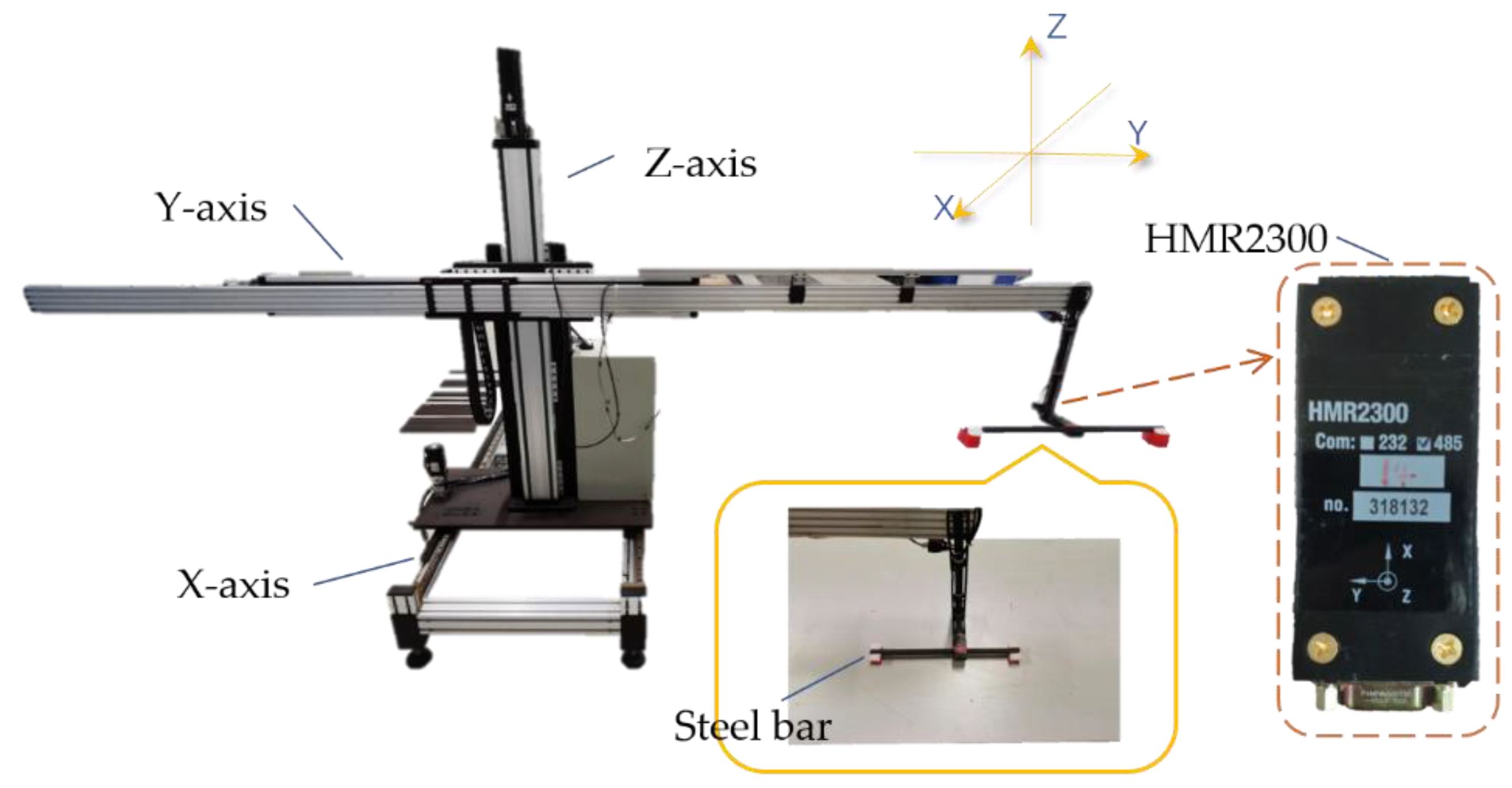
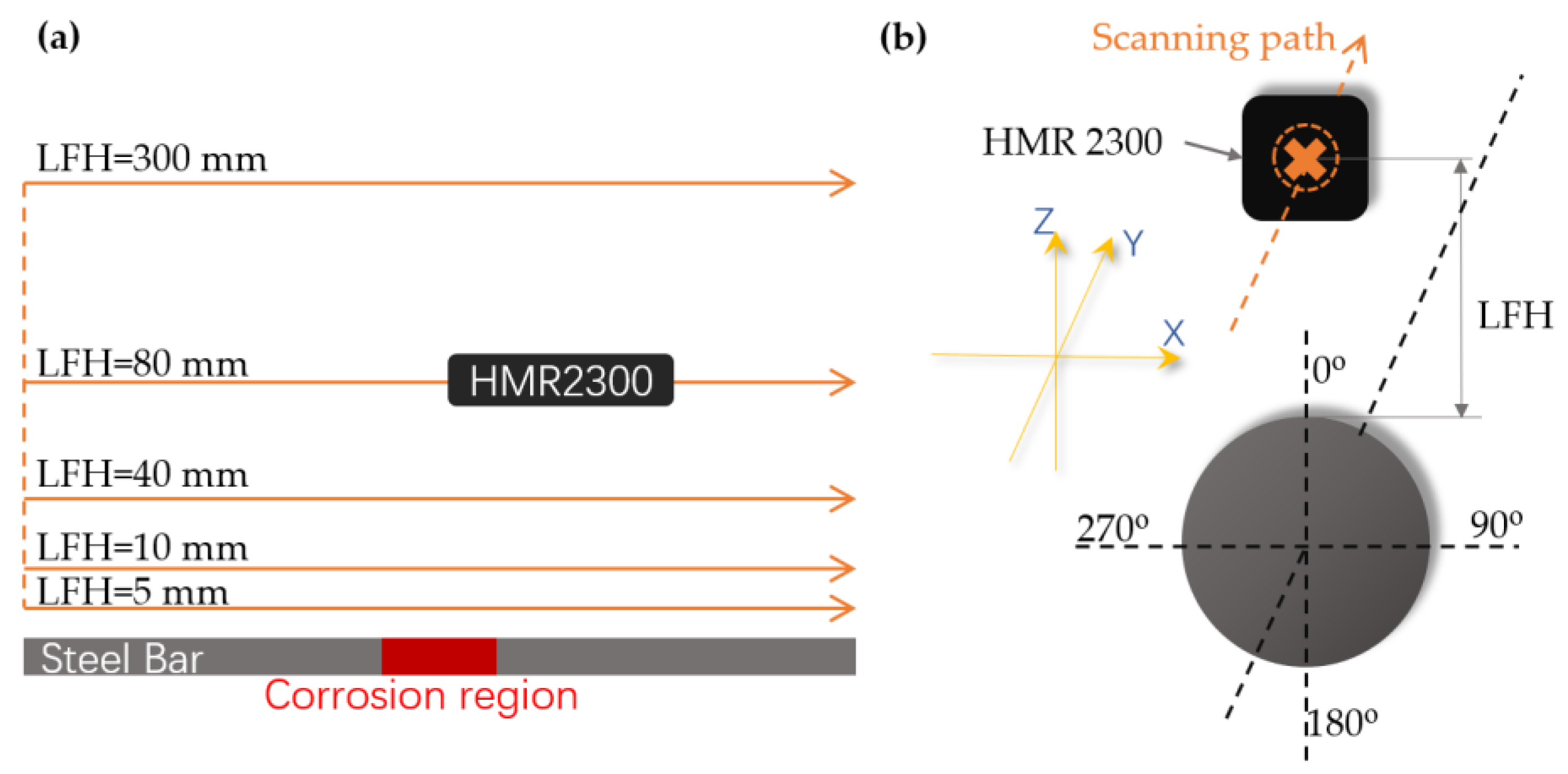
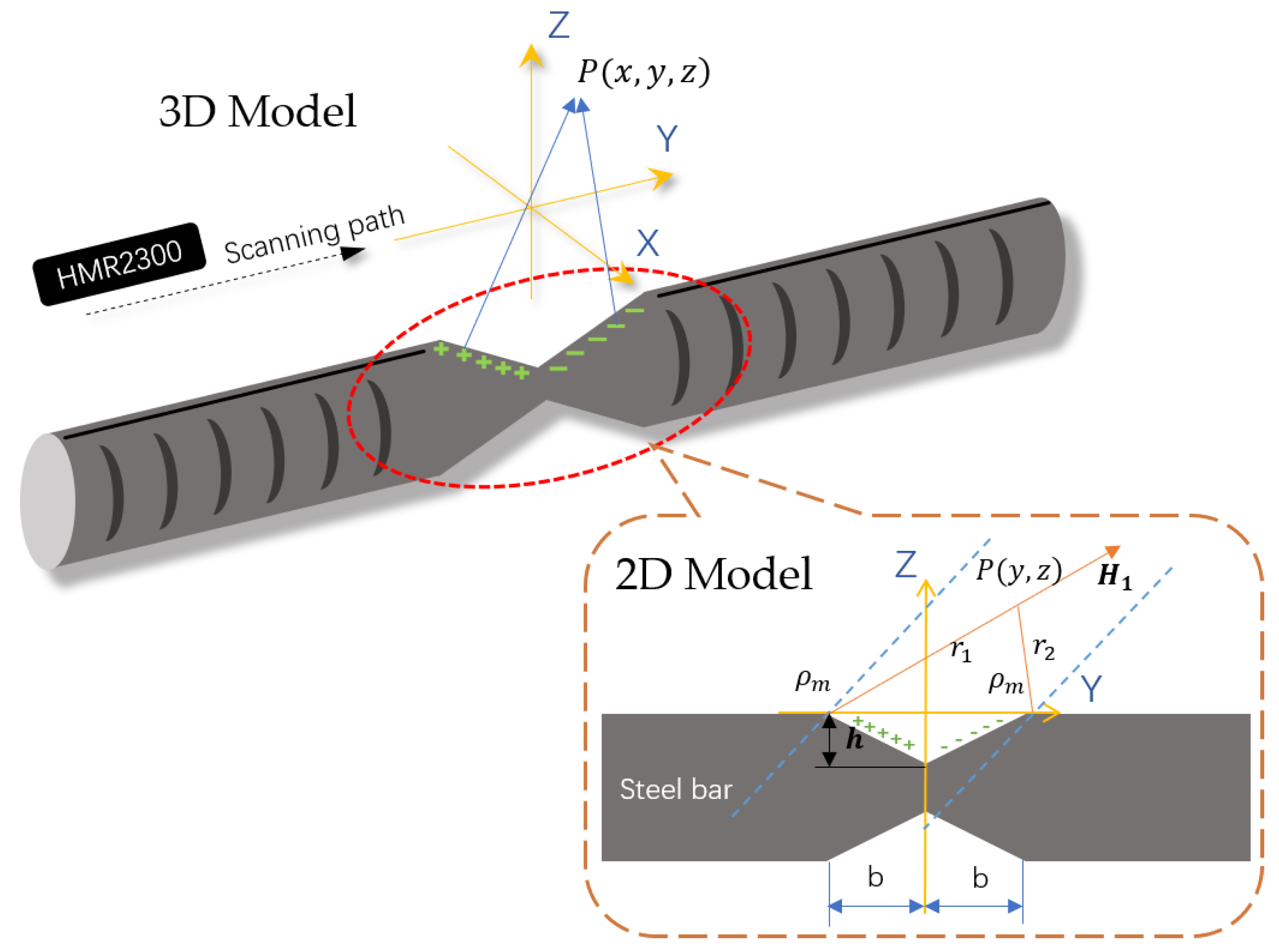

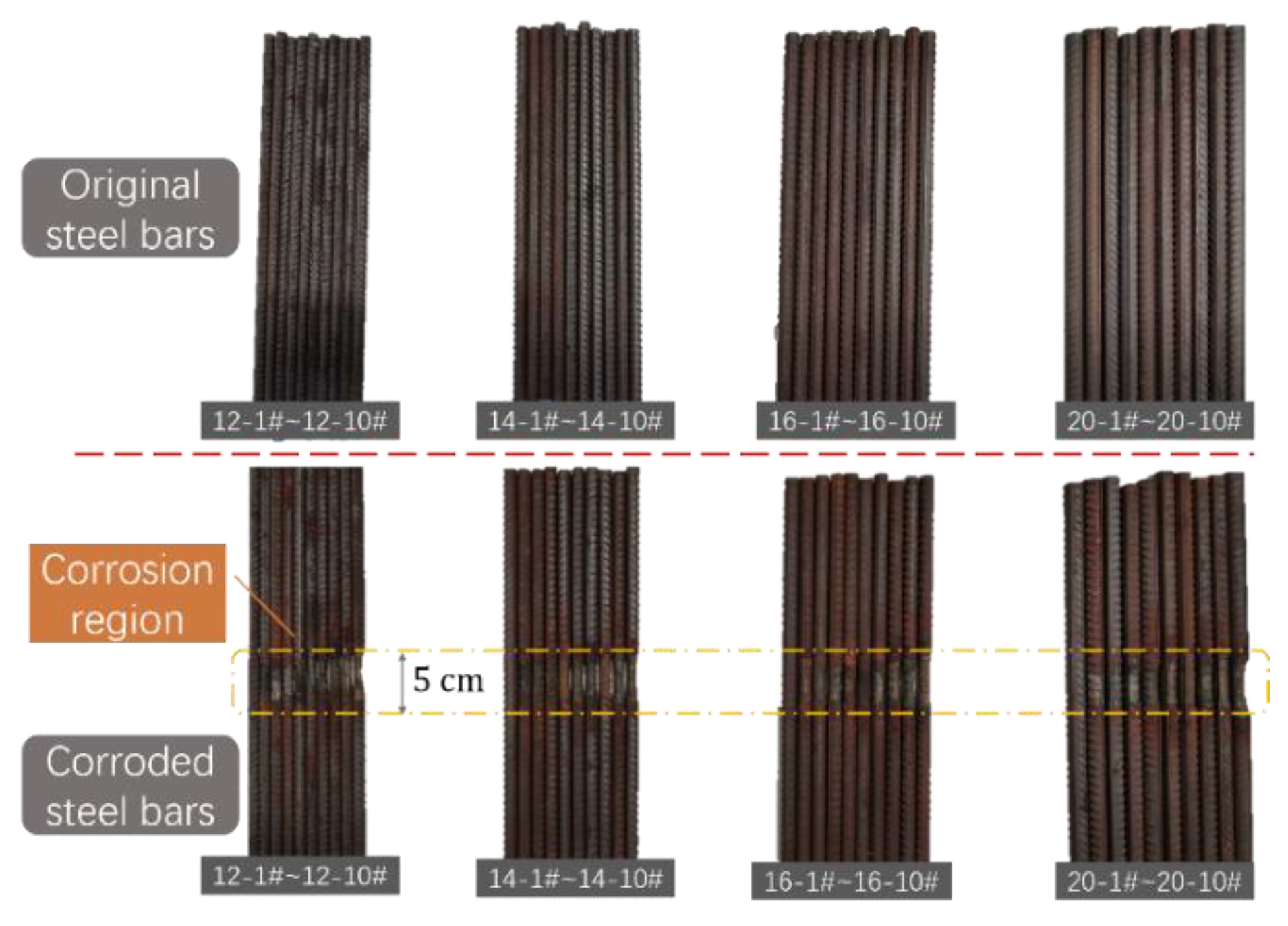

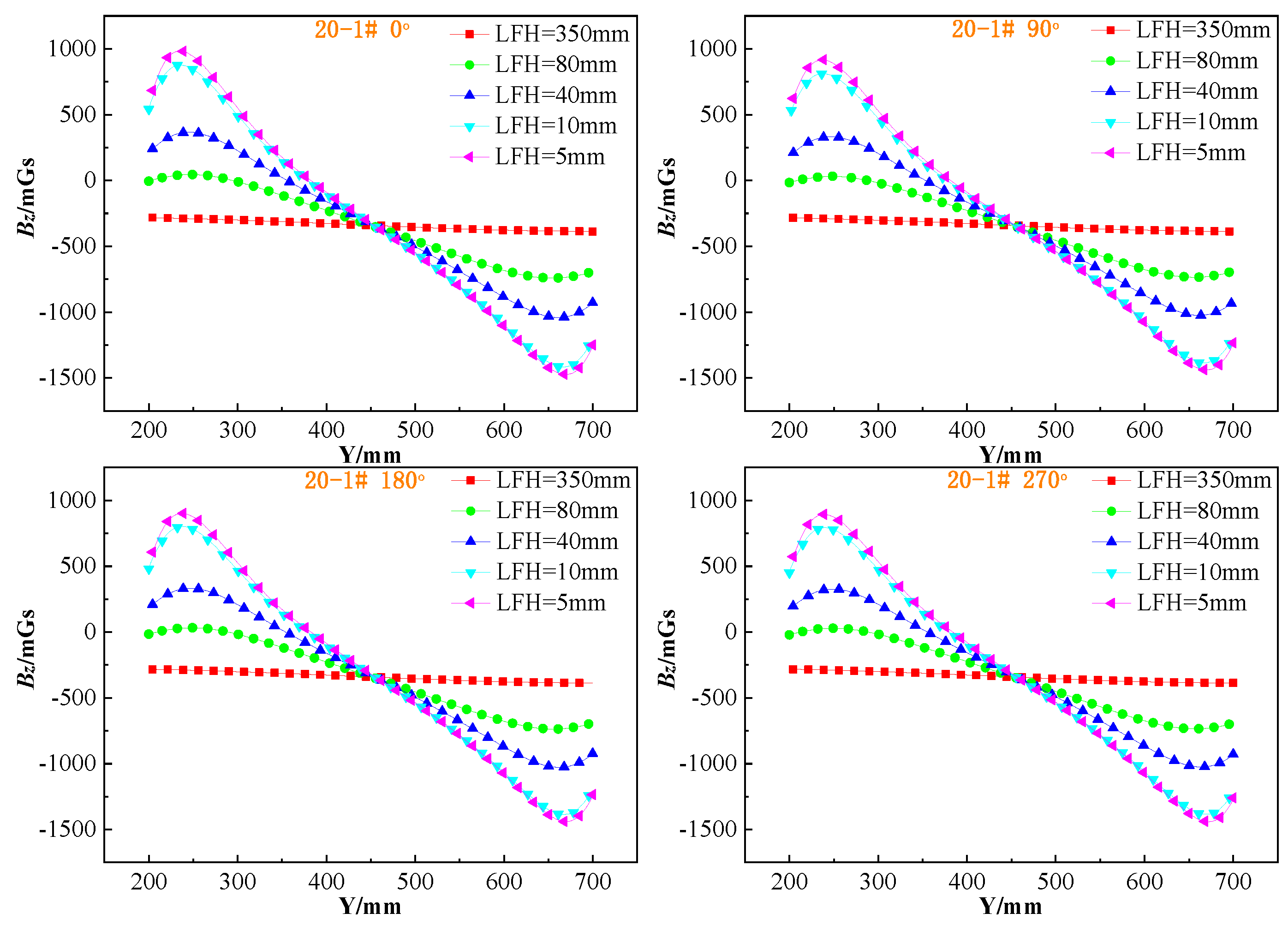

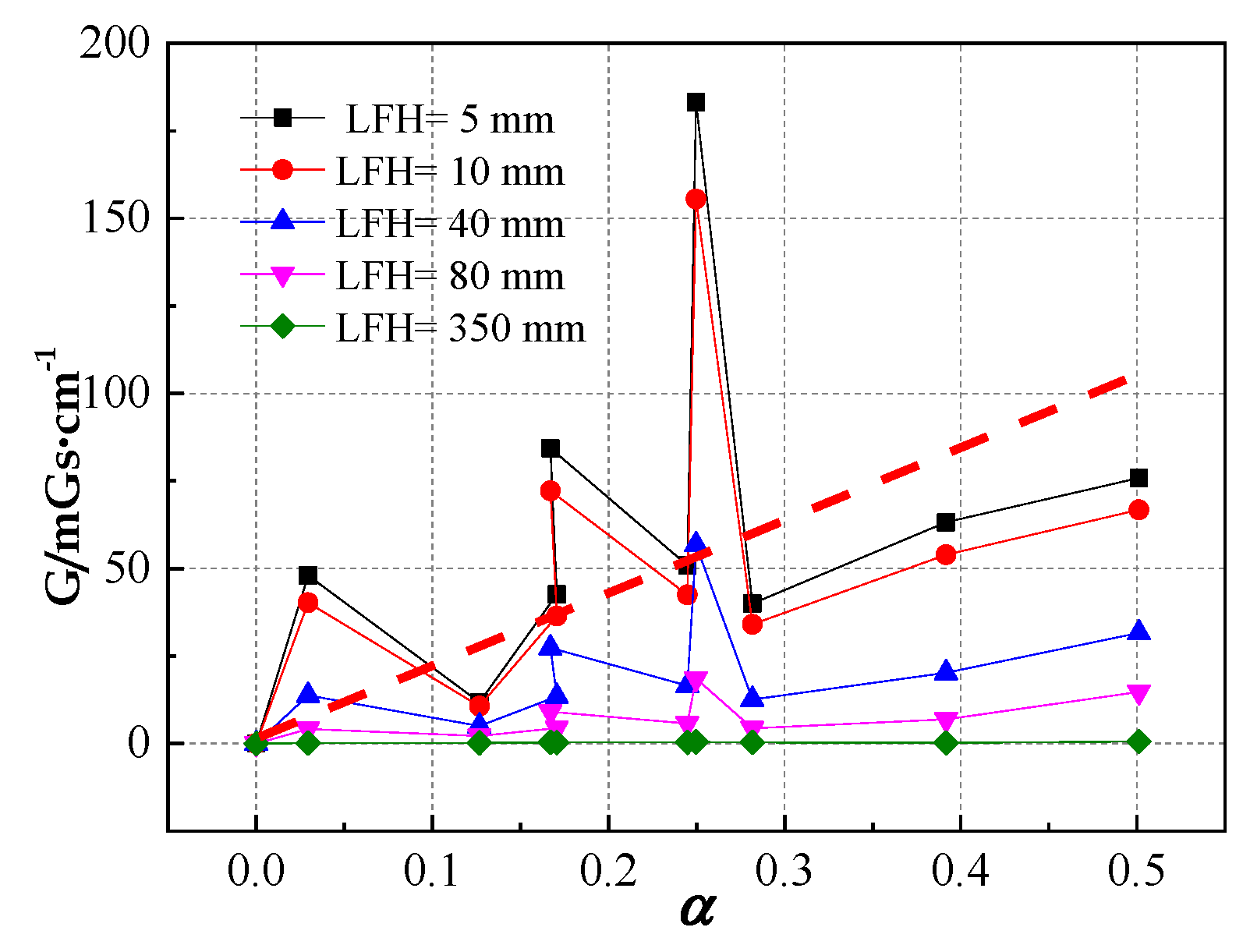
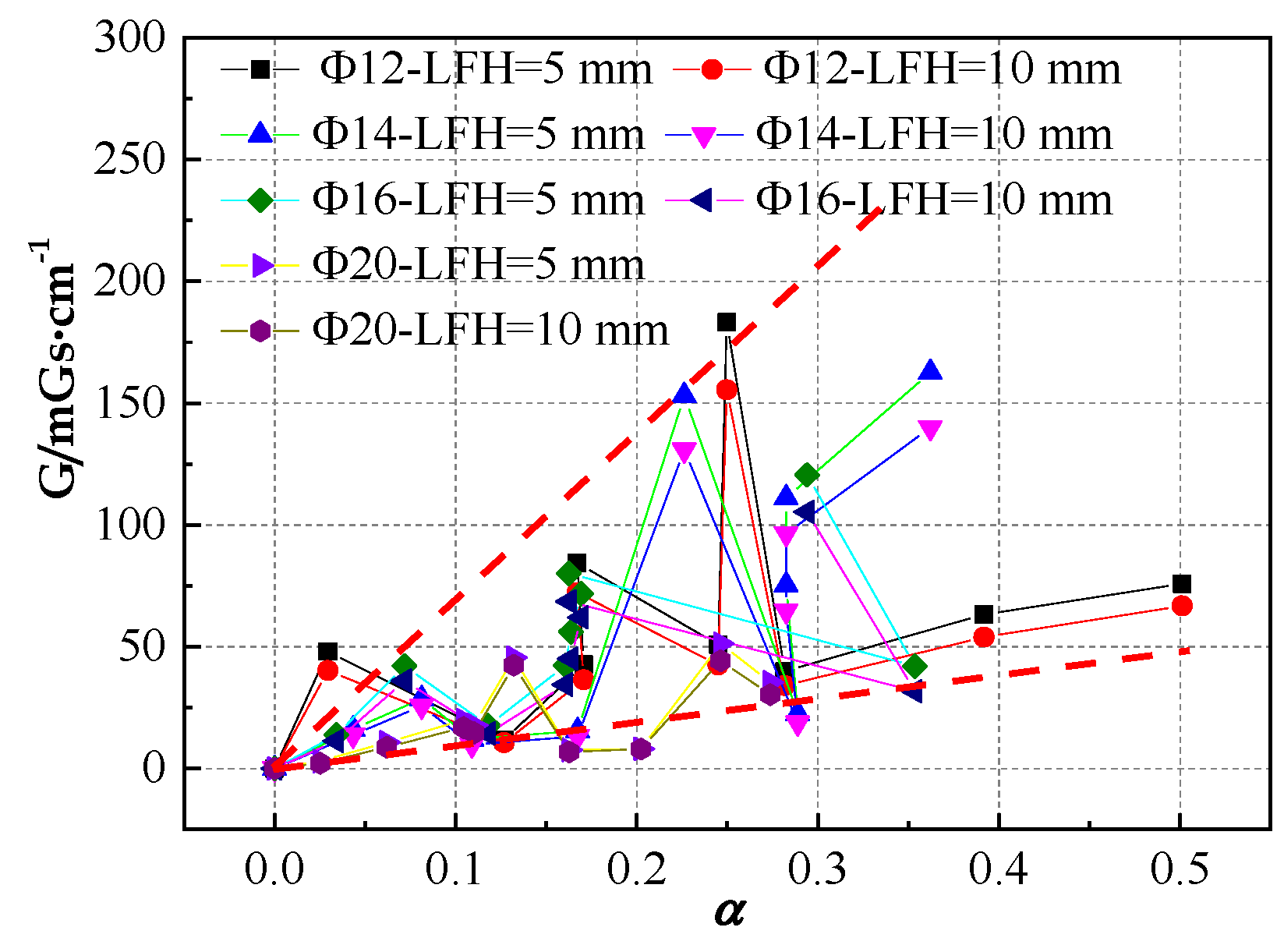
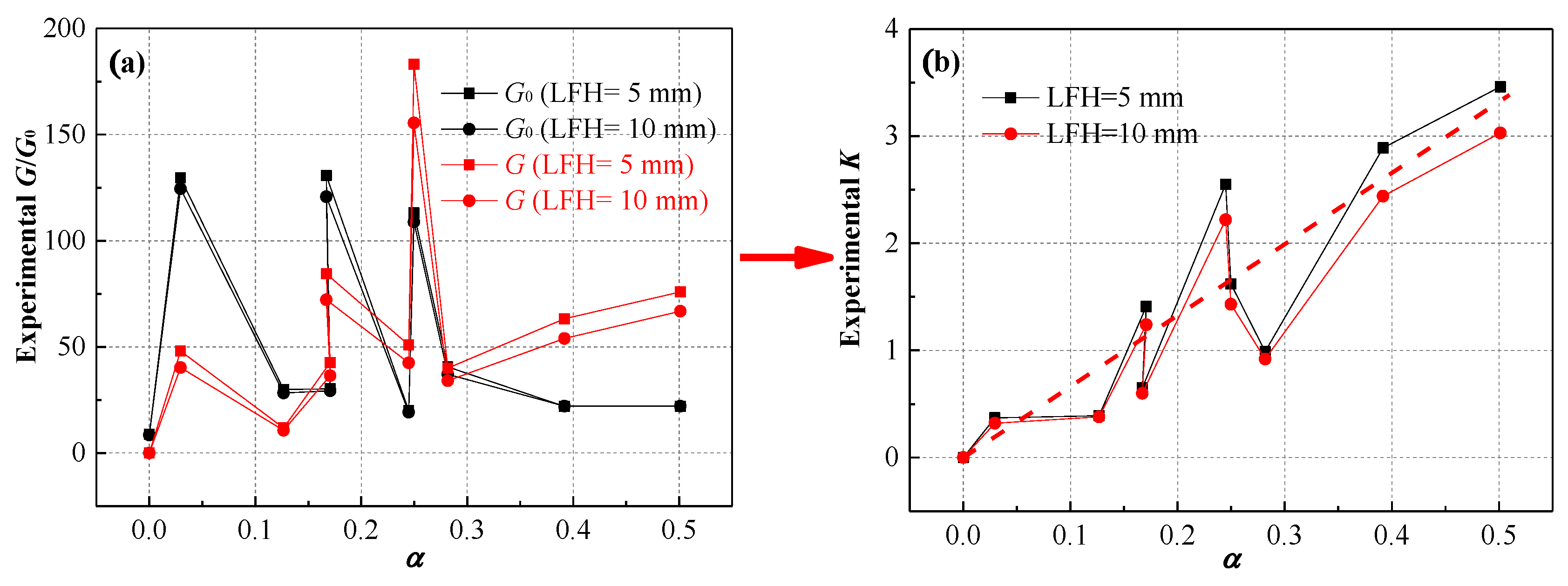

| Type of Steel | Diameter/mm | Density g/cm2 | Component, wt.% | ||||
|---|---|---|---|---|---|---|---|
| C | Mn | Si | P | S | |||
| HRB400 | 12 | 7.9 | 0.22 | 1.4 | 0.5 | 0.02 | 0.01 |
| 14 | |||||||
| 16 | |||||||
| 20 | |||||||
| Number | T/h | I/A | S/% | dm/mm | Number | T/h | I/A | S/% | dm/mm |
|---|---|---|---|---|---|---|---|---|---|
| 12-1# | 0 | 1.09 | 0 | 12.00 | 16-1# | 0 | 1.29 | 0 | 16.00 |
| 12-2# | 2 | 1.09 | 10.0 | 11.38 | 16-2# | 3 | 1.29 | 10.0 | 15.17 |
| 12-3# | 4 | 1.09 | 20.0 | 10.73 | 16-3# | 6 | 1.29 | 20.0 | 14.31 |
| 12-4# | 6 | 1.09 | 29.7 | 10.06 | 16-4# | 9 | 1.29 | 29.7 | 13.42 |
| 12-5# | 8 | 1.09 | 39.1 | 9.36 | 16-5# | 12 | 1.29 | 39.1 | 12.49 |
| 12-6# | 10 | 1.09 | 48.3 | 8.63 | 16-6# | 15 | 1.29 | 48.3 | 11.51 |
| 12-7# | 12 | 1.09 | 57.1 | 7.86 | 16-7# | 18 | 1.29 | 57.1 | 10.48 |
| 12-8# | 14 | 1.09 | 65.6 | 7.04 | 16-8# | 21 | 1.29 | 65.6 | 9.39 |
| 12-9# | 16 | 1.09 | 73.6 | 6.17 | 16-9# | 24 | 1.29 | 73.6 | 8.23 |
| 12-10# | 18 | 1.09 | 81.0 | 5.23 | 16-10# | 27 | 1.29 | 81.0 | 6.97 |
| 14-1# | 0 | 1.49 | 0 | 14.00 | 20-1# | 0 | 1.52 | 0 | 20.00 |
| 14-2# | 2 | 1.49 | 10.0 | 13.27 | 20-2# | 4 | 1.52 | 10.0 | 18.96 |
| 14-3# | 4 | 1.49 | 20.0 | 12.52 | 20-3# | 8 | 1.52 | 20.0 | 17.89 |
| 14-4# | 6 | 1.49 | 29.7 | 11.74 | 20-4# | 12 | 1.52 | 29.7 | 16.77 |
| 14-5# | 8 | 1.49 | 39.1 | 10.92 | 20-5# | 16 | 1.52 | 39.1 | 15.61 |
| 14-6# | 10 | 1.49 | 48.3 | 10.07 | 20-6# | 20 | 1.52 | 48.3 | 14.39 |
| 14-7# | 12 | 1.49 | 57.1 | 9.17 | 20-7# | 24 | 1.52 | 57.1 | 13.10 |
| 14-8# | 14 | 1.49 | 65.6 | 8.22 | 20-8# | 28 | 1.52 | 65.6 | 11.74 |
| 14-9# | 16 | 1.49 | 73.6 | 7.20 | 20-9# | 32 | 1.52 | 73.6 | 10.23 |
| 14-10# | 18 | 1.49 | 81.0 | 6.10 | 20-10# | 36 | 1.52 | 81.0 | 8.72 |
| Number | D0/mm | Dc/mm | Number | D0/mm | Dc/mm |
|---|---|---|---|---|---|
| 12-1# | 11.39 | 11.39 | 16-1# | 15.28 | 15.28 |
| 12-2# | 10.99 | 10.69 | 16-2# | 15.27 | 14.75 |
| 12-3# | 11.37 | 9.93 | 16-3# | 15.37 | 14.27 |
| 12-4# | 11.21 | 9.30 | 16-4# | 15.37 | 13.56 |
| 12-5# | 11.42 | 9.51 | 16-5# | 15.41 | 12.93 |
| 12-6# | 11.42 | 8.62 | 16-6# | 15.33 | 12.82 |
| 12-7# | 11.05 | 8.29 | 16-7# | 15.25 | 12.67 |
| 12-8# | 11.47 | 8.24 | 16-8# | 15.35 | 12.86 |
| 12-9# | 11.40 | 6.94 | 16-9# | 15.25 | 9.86 |
| 12-10# | 11.38 | 5.68 | 16-10# | 15.32 | 10.82 |
| 14-1# | 13.14 | 13.14 | 20-1# | 19.17 | 19.17 |
| 14-2# | 13.05 | 12.49 | 20-2# | 19.03 | 18.55 |
| 14-3# | 13.23 | 12.16 | 20-3# | 19.17 | 17.98 |
| 14-4# | 13.07 | 11.64 | 20-4# | 19.02 | 17.04 |
| 14-5# | 13.15 | 10.95 | 20-5# | 19.07 | 16.97 |
| 14-6# | 13.06 | 10.11 | 20-6# | 19.04 | 16.53 |
| 14-7# | 12.84 | 9.13 | 20-7# | 19.16 | 16.05 |
| 14-8# | 13.19 | 9.46 | 20-8# | 19.02 | 15.17 |
| 14-9# | 13.05 | 9.36 | 20-9# | 19.17 | 14.45 |
| 14-10# | 13.12 | 9.17 | 20-10# | 19.05 | 13.84 |
| Number | α | Number | α | Number | α | Number | α |
|---|---|---|---|---|---|---|---|
| 12-1# | 0.00 | 14-1# | 0.00 | 16-1# | 0.00 | 20-1# | 0.00 |
| 12-2# | 0.03 | 14-2# | 0.04 | 16-2# | 0.03 | 20-2# | 0.03 |
| 12-3# | 0.13 | 14-3# | 0.08 | 16-3# | 0.07 | 20-3# | 0.06 |
| 12-4# | 0.17 | 14-4# | 0.11 | 16-4# | 0.12 | 20-4# | 0.10 |
| 12-5# | 0.17 | 14-5# | 0.17 | 16-5# | 0.16 | 20-5# | 0.11 |
| 12-6# | 0.24 | 14-6# | 0.23 | 16-6# | 0.16 | 20-6# | 0.13 |
| 12-7# | 0.25 | 14-7# | 0.29 | 16-7# | 0.17 | 20-7# | 0.16 |
| 12-8# | 0.28 | 14-8# | 0.28 | 16-8# | 0.16 | 20-8# | 0.20 |
| 12-9# | 0.39 | 14-9# | 0.28 | 16-9# | 0.35 | 20-9# | 0.25 |
| 12-10# | 0.50 | 14-10# | 0.28 | 16-10# | 0.29 | 20-10# | 0.27 |
© 2019 by the authors. Licensee MDPI, Basel, Switzerland. This article is an open access article distributed under the terms and conditions of the Creative Commons Attribution (CC BY) license (http://creativecommons.org/licenses/by/4.0/).
Share and Cite
Yang, D.; Qiu, J.; Di, H.; Zhao, S.; Zhou, J.; Yang, F. Quantitative Evaluation of Corrosion Degrees of Steel Bars Based on Self-Magnetic Flux Leakage. Metals 2019, 9, 952. https://doi.org/10.3390/met9090952
Yang D, Qiu J, Di H, Zhao S, Zhou J, Yang F. Quantitative Evaluation of Corrosion Degrees of Steel Bars Based on Self-Magnetic Flux Leakage. Metals. 2019; 9(9):952. https://doi.org/10.3390/met9090952
Chicago/Turabian StyleYang, Ding, Junli Qiu, Haibo Di, Siyu Zhao, Jianting Zhou, and Feixiong Yang. 2019. "Quantitative Evaluation of Corrosion Degrees of Steel Bars Based on Self-Magnetic Flux Leakage" Metals 9, no. 9: 952. https://doi.org/10.3390/met9090952
APA StyleYang, D., Qiu, J., Di, H., Zhao, S., Zhou, J., & Yang, F. (2019). Quantitative Evaluation of Corrosion Degrees of Steel Bars Based on Self-Magnetic Flux Leakage. Metals, 9(9), 952. https://doi.org/10.3390/met9090952






